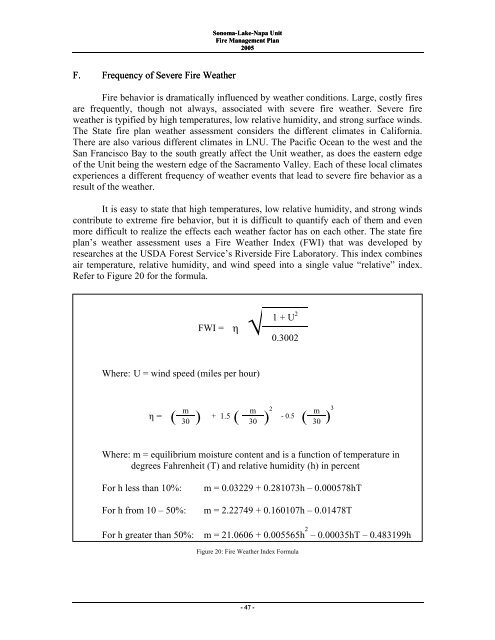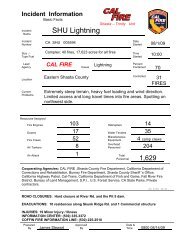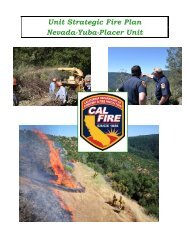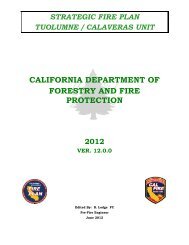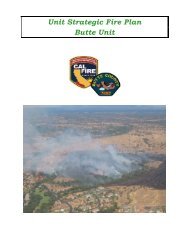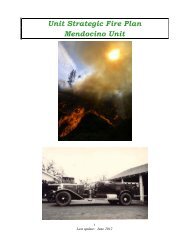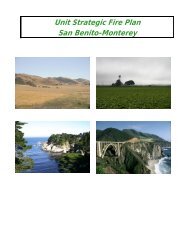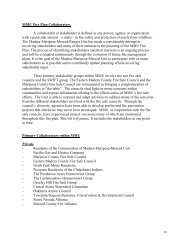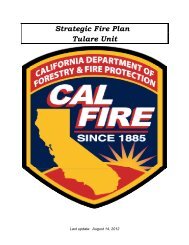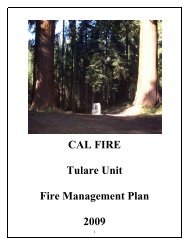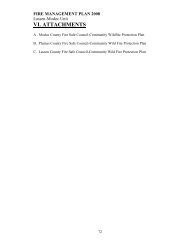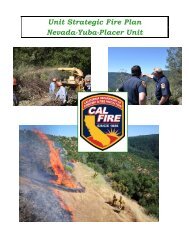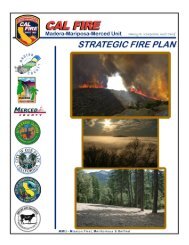Sonoma-Lake-Napa Fire Plan - Board of Forestry and Fire ...
Sonoma-Lake-Napa Fire Plan - Board of Forestry and Fire ...
Sonoma-Lake-Napa Fire Plan - Board of Forestry and Fire ...
You also want an ePaper? Increase the reach of your titles
YUMPU automatically turns print PDFs into web optimized ePapers that Google loves.
F. Frequency <strong>of</strong> Severe <strong>Fire</strong> Weather<br />
<strong>Sonoma</strong>-<strong>Lake</strong>-<strong>Napa</strong> Unit<br />
<strong>Fire</strong> Management <strong>Plan</strong><br />
2005<br />
<strong>Fire</strong> behavior is dramatically influenced by weather conditions. Large, costly fires<br />
are frequently, though not always, associated with severe fire weather. Severe fire<br />
weather is typified by high temperatures, low relative humidity, <strong>and</strong> strong surface winds.<br />
The State fire plan weather assessment considers the different climates in California.<br />
There are also various different climates in LNU. The Pacific Ocean to the west <strong>and</strong> the<br />
San Francisco Bay to the south greatly affect the Unit weather, as does the eastern edge<br />
<strong>of</strong> the Unit being the western edge <strong>of</strong> the Sacramento Valley. Each <strong>of</strong> these local climates<br />
experiences a different frequency <strong>of</strong> weather events that lead to severe fire behavior as a<br />
result <strong>of</strong> the weather.<br />
It is easy to state that high temperatures, low relative humidity, <strong>and</strong> strong winds<br />
contribute to extreme fire behavior, but it is difficult to quantify each <strong>of</strong> them <strong>and</strong> even<br />
more difficult to realize the effects each weather factor has on each other. The state fire<br />
plan’s weather assessment uses a <strong>Fire</strong> Weather Index (FWI) that was developed by<br />
researches at the USDA Forest Service’s Riverside <strong>Fire</strong> Laboratory. This index combines<br />
air temperature, relative humidity, <strong>and</strong> wind speed into a single value “relative” index.<br />
Refer to Figure 20 for the formula.<br />
- 47 -<br />
1 + U 2<br />
FWI = η √ 0.3002<br />
Where: U = wind speed (miles per hour)<br />
m m m<br />
η = ( 30 ) + 1.5 ( 30 ) 2<br />
- 0.5 ( 30 ) 3<br />
Where: m = equilibrium moisture content <strong>and</strong> is a function <strong>of</strong> temperature in<br />
degrees Fahrenheit (T) <strong>and</strong> relative humidity (h) in percent<br />
For h less than 10%: m = 0.03229 + 0.281073h – 0.000578hT<br />
For h from 10 – 50%: m = 2.22749 + 0.160107h – 0.01478T<br />
For h greater than 50%: m = 21.0606 + 0.005565h 2<br />
– 0.00035hT – 0.483199h<br />
Figure 20: <strong>Fire</strong> Weather Index Formula


